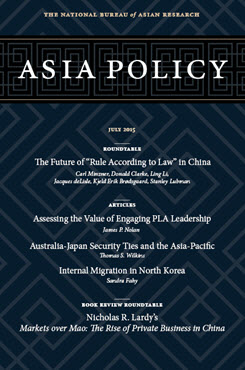From Strategic Partnership to Strategic Alliance?
Australia-Japan Security Ties and the Asia-Pacific
This article addresses the developing security relationship between Australia and Japan and assesses implications for the U.S. and the region.
EXECUTIVE SUMMARY
MAIN ARGUMENT
Based on a series of unprecedented developments, Australia and Japan have greatly enhanced their direct bilateral security ties to forge what they now describe as a “special strategic partnership.” This new form of security alignment is not intended to be a traditional alliance pact, but rather represents a novel and versatile mechanism for diplomatic, security, and economic cooperation. Both states seek to pragmatically advance their national interests in tandem and to multiply their capabilities to meet joint security challenges in the Asia-Pacific. In this case, however, the strength and significance of the strategic partnership is further buttressed as a consequence of their adjunct status as “quasi-allies”—through their independent defense pacts with the U.S.—and their combined participation in the Trilateral Strategic Dialogue.
POLICY IMPLICATIONS
- The rapid emergence and subsequent strengthening of the Australia-Japan strategic partnership is one of the most significant recent developments in the regional security landscape, and especially within the context of the U.S. hub-and-spoke alliance system.
- The strategic partnership is actually a new form of security alignment whose nature, function, and dynamics are not well appreciated or understood. A robust debate is developing among the strategic community in Australia regarding the desirability of deepening this security relationship and whether it portends a treaty-based military alliance pact.
- The impact of this partnership on the regional security environment is seemingly inconsistent. On the one hand, this intra-allied cooperation appears to reinforce the overall U.S. alliance system in the Asia-Pacific. On the other, it could represent a nascent effort by key “middle powers” to hedge against the breakdown of this system.
NOTE: The author would like to thank Malcolm Cook, Alan Dupont, and John Lee for their assistance with earlier drafts. He would also like to extend appreciation to his research intern at the University of Sydney, Jiye Kim, as well as to Asia Policy‘s anonymous reviewers for their constructive feedback. Last, the Australia-Japan Foundation is gratefully acknowledged for its support of research conducted in relation to this article.
About Asia Policy
Asia Policy is a peer-reviewed scholarly journal presenting policy-relevant academic research on the Asia-Pacific that draws clear and concise conclusions useful to today’s policymakers. Asia Policy is published quarterly in January, April, July, and October and accepts submissions on a rolling basis. Learn more


